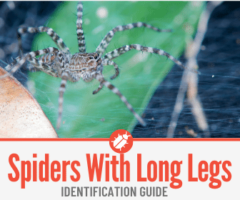 Are you a cricket enthusiast? A frustrated homeowner trying to empty your house of these insects? Or maybe one too many crickets has escaped the bag before being fed to your pet?
Are you a cricket enthusiast? A frustrated homeowner trying to empty your house of these insects? Or maybe one too many crickets has escaped the bag before being fed to your pet?
Whatever your individual reason for wondering how high can crickets jump, we have the information you need.
Do Crickets Jump?
The short answer is yes, all crickets can jump. However, the distance they can cover with one leap varies between species.
Some cricket species can jump about three feet high, or 20 to 30 times their body length. Others can leap even farther, covering distances of about 50 to 60 times their body lengths.
Crickets have powerfully built legs that specialize in jumping very far and very high. The larger the hind legs, the more distance they can cover with one leap.
While they are walking, they often keep these back legs raised above the ground. This lets them rely on their other legs and reserve the larger ones for jumps.
Not only are they able to take off quickly, they land on their back legs, preventing them from falling over. This also prepares them to take their next jump quickly.
While both back legs are able to move at the same time, sometimes crickets will begin a jump with only one leg. Crickets can jump on any surface, including a bed or glass pane.
Crickets That Jump
Your average house cricket can jump up to three feet at a time. Not sure how to spot a house cricket? Look for a brownish colored insect slightly smaller than an inch with wings on the top of its body.
Another species of cricket that is frequently found indoors is the field cricket.
Like the closely related house cricket, it too can jump a distance of close to three feet. These crickets are a darker brown in color and are closer to an inch in length, with powerful back legs.
If you’ve ever come across a camel cricket, you probably have a story to tell about how it jumps (or how it looks).
Learn More: Why do Camel Crickets jump at you
Camel crickets are big leapers and can jump up to five feet in any direction (about 50 to 60 times their body length). They come out at night and often dwell in dark areas, like basements.
Like their name suggests, they have a hump-like curve on their back and are often mistaken for spiders. They are various shades of brown without wings and can grow to be over an inch long.
If you’ve seen a cricket inside your house, it is most likely a house cricket. There are several other types of crickets that live outdoors which also have powerful hind legs. They use these for jumping.
More examples?
Take a tree cricket, whose color is greener than a house cricket in order to blend in with its environment. Tree crickets may look different than other crickets, but they still use their large legs for jumping.
Crickets That Don’t Jump
Crickets are insects that overwhelmingly rely on their ability to jump in order to travel. While there are no crickets that don’t jump, there are some species that can jump farther distances than others.
Camel crickets and house crickets, for example, have a larger jumping range of about three to five feet. Many other species can jump far less than that.
Comparison Between Different Jumping Crickets
- Camel Crickets
How high can camel crickets jump? Camel crickets are known for their jumping skills. Not only can they jump up to three feet high in the air, they can also leap forward a distance of about five feet.
This means that they can easily jump up onto the average bed or make it quickly across a room. With longer legs than most other crickets, they are built perfectly for all the jumping that they do.
Related: Do Camel Spider Crickets bite
- House Crickets
Common house crickets can jump about three feet high in the air. Not sure how to picture that three feet? Imagine a coffee table or a couch.
Like most crickets, they have legs built for jumping, but they do sometimes fly as well.
- Feeder Crickets
If you have some kind of reptile as a pet, chances are you’ve fed them crickets at one point or another.
These feeder crickets are usually just house crickets, casually renamed for the purpose they are serving. Feeder Crickets can jump about three feet high
- Field Crickets
Similar to a house cricket, a field cricket can jump about three feet high. This means that they can cause quite a surprise with a single jump.
- Pygmy Mole Crickets
Usually found by the water, pygmy mole crickets are able to jump distances of a little over two feet high. Considering that they are only about six millimeters long as adults, this is an impressive feat!
Do Crickets Fly or Jump?
Because crickets also have wings, it can be difficult to know if they are jumping or flying when they’re moving around.
While some crickets do have the ability to use their wings for flight, most cricket species rely solely on their legs.
Of the most commonly found crickets near houses and buildings, house crickets and field crickets both fly in addition to jumping. This means that while they use their powerful legs more often, they do have the capability to fly when needed.
You won’t usually catch them soaring around during the day, however. Normally they only fly at night towards any source of light.
Unlike house and field crickets, Camel crickets can’t fly. Jumping and leaping are their only forms of movement.
Because they both have strong hind legs, they are able to jump long distances as well as reach high heights during these jumps.
Why do the crickets who can’t fly have wings? Those wings are very important in communication! Crickets rub them together to create the classic “chirping” sound.
Any crickets with wings can make this sound, but those without are silent insects. If you hear crickets in your house, they are most likely a House or Field cricket (remember, camel crickets do not have wings).
Can Crickets Jump Backwards?
When crickets jump, they move forward. Because they use their hind legs to power their jumps, this motion carries them forwards rather than backwards.
If crickets are approached by a predator from the side, they will not be able to take off as efficiently.
This results in a shorter jump than normal.
Can crickets jump straight up? Good question. They do gain some height as they leap, but they do not jump straight up and down. Rather, they jump to propel themselves forward.
Conclusion
Overall crickets are strong jumpers. Although some species fly occasionally, they primarily move around using their large legs.
If you see crickets around your house, keep in mind that they will be able to jump. But remember, even if they can be frustrating they are not harmful!






